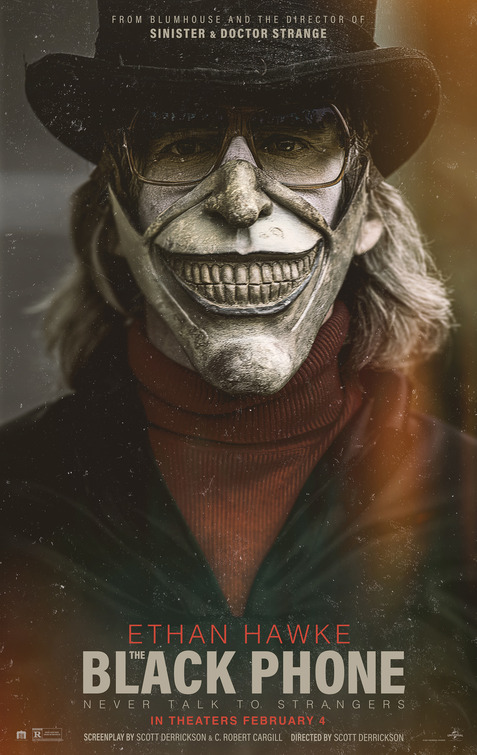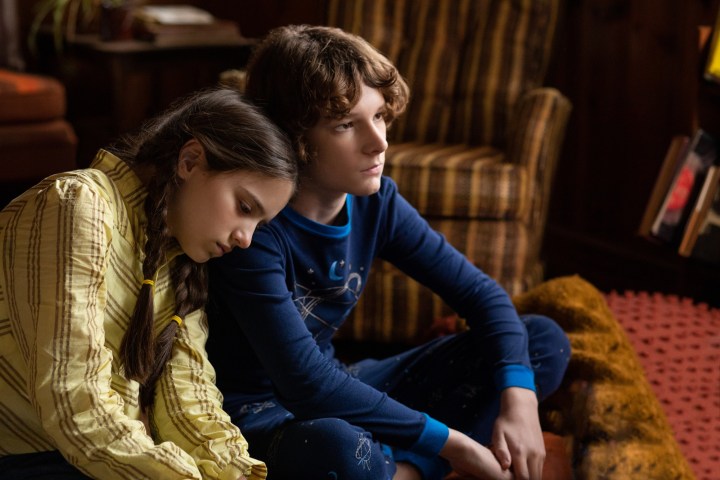
Thanks to The Black Phone, I have to qualify my usual declaration that the book is always better than the movie. Well, in this case, it’s a short story. The film expands the original tale in every direction, increasing its range and impact, yet still maintaining the core elements of the story and key lines of dialogue. Child abductions are far too common to be taken lightly, so the filmmakers smartly crafted an experience that never crosses the line from horror to exploitation. Moviegoers know what happened, so you don’t need to explicitly show them. Postponements kept this production out of theaters for almost a year until now. The result was worth the extra wait. The Black Phone perfectly mixes ghosts, survival, revenge and a memorable maniac for a horror flick that builds to a thrilling climax.
Joe Hill’s titular short story was published in a British horror magazine in 2004. Much like his famous father Stephen King’s early career, Hill has written a lot of short stories and a handful of novels, one of which (NOS4A2) was turned into a television series. Hill’s version focuses on the latest abducted child in a suburban neighborhood and his fight for survival. Writer/director Scott Derrickson (The Exorcism of Emily Rose, Sinister, Deliver Us from Evil and Doctor Strange) and writer C. Robert Cargill collaborated before on Sinister, Sinister 2 and Doctor Strange. Taking place in Denver in 1978, this adaptation focuses on the strong bond between Finney (Mason Thames) and his sister Gwen (Madeleine McGraw), made even tighter as they deal with an abusive, alcoholic father (Jeremy Davies). When Finney gets abducted by the local boogeyman known as The Grabber (Ethan Hawke), Gwen never stops looking for him as he tries to stay alive and escape from an underground lair with the help of some unexpected allies and his own ingenuity.
Hawke avoids top billing in the titles with one of those “and Ethan Hawke” entries because the real stars here are the child actors. Both Thames and McGraw are captivating and believable. In fact, I wonder what the movie would have been like had their roles been reversed and Gwen was kidnapped. Thames plays easygoing and thoughtful, while McGraw acts like a little spitfire with a mouth like a sailor and a tough exterior. Other notable child actors stand out as bullies at Finney and Gwen’s school and as ghosts of The Grabber’s previous victims, which provides a unique experience. Hawke tries his hand at horror every now and then with such films as Daybreakers, The Purge and Sinister, so I’m happy to see him go even deeper as this disturbed individual. Many actors wouldn’t even attempt such a part as a child abductor these days, and Hawke makes The Grabber creepy yet somehow welcoming. I’ll never forget Davies in Saving Private Ryan, and his luckless character here has his reasons for being so damaged. James Ransone has one of those faces that you never forget, and he adds to his extensive list of credits with this minor but crucial character.
The special effects shock at times, and there are some bloody good fight scenes, too. The ghosts bear the scars of their final days and hours at the hands of The Grabber. You never know when they’re going to show up, which keeps you on edge because, uniquely, you see them while Finney can only talk to them on the titular device that is one relic in the lair from a previous owner or business. I’d have to watch again to be sure, but I’m fairly certain that Hawke’s face is never seen without some sort of mask, full or partial. Founded by veteran effects artist Jason Baker and legendary makeup effects artist Tom Savini, Pittsburgh-based Callosum Studios supplied the variety of masks for Hawke, adding to The Grabber’s personality at various times. Some masks are scarier than others, and the one on the poster almost looks like a person splayed out on the hood of a car with the teeth as the grill. Look up Savini’s design for Fluffy from Creepshow, and you’ll see some aesthetic similarities to The Grabber’s face coverings.
The Black Phone takes 25 minutes to set up the rest of the movie. In most cases, I would complain about such time taken away from the main plot, but it all proves important as the story progresses. The filmmakers clearly wanted to evoke the feeling and presentation of King’s own stories on the big screen. They successfully mixed together without being obnoxious kids being kids, bullies hurting said kids, someone with possible psychic powers and nostalgic touches of the time period (music, fashion, TV shows, props and even an old pinball machine). The use of black balloons as imagery for The Grabber immediately reminded me of Pennywise and his red balloons from It. One of the most powerful presentations of the ghosts resonates even now. Finney talks to them through the supposedly broken phone, and you eerily see them speaking right next to him with their dialogue still that faraway distinct sound of a human voice over the line.
The Black Phone wins you over with its fresh take on an age-old situation and even throws in a twist that wasn’t necessary or expected. Many horror flicks rely on phony, stupid jump scares to deliver the fear, whereas these filmmakers only use two great ones that fit the scenes rather than take you out of them. Composer Mark Korven (The Witch and The Lighthouse, among many others) keeps you off-kilter with a variety of spooky, moody music and some bizarre synthesizer sounds in the third act. The sign of a great horror film is audience participation or cheering. There’s a lot of that in the last half-hour. Blumhouse Productions notches another winner. The Black Phone may be a rotary model, but there’s no question that it pushes all the right buttons to satisfy horror fans.



